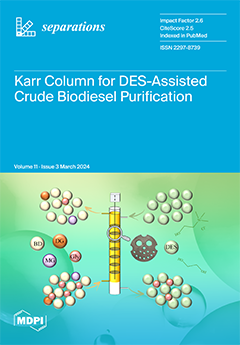Microfiltration plays an increasingly important role in various fields. Consequently, elucidating the mechanism of membrane fouling has emerged as a pivotal issue that needs to be resolved. In this study, a blocking filtration model was employed to evaluate the effects of membrane properties on the fouling mechanism during the microfiltration of representative polysaccharides, namely sodium alginate, pectin, and xanthan gum. Microfiltration membranes composed of hydrophilic and hydrophobic PVDF, mixed cellulose ester, as well as hydrophilic and hydrophobic PTFE were used as filter media. The flux decline behavior was significantly affected by the membrane properties, with hydrophilic membranes exhibiting a slower decrease in filtration rate. The model analysis revealed a correlation between the blocking characteristic values and the membrane properties. Although the blocking index
n showed membrane material dependence, the values of this parameter remained consistent across various filtration conditions, including the wettability of the membrane surface, solute concentration, and pressure (pectin:
n = 1.86, 1.85, 1.50, and 1.50 for hydrophilic PVDF, hydrophobic PVDF, hydrophilic PTFE, and hydrophobic PTFE, respectively). The resistance coefficient
k was influenced by the characteristics of the membrane surface; the
k values of the hydrophobic membranes were higher than those of the hydrophilic ones (pectin:
k = 0.00084, 0.00725, 0.00714, and 0.0384 s
1−n/cm
2−n for hydrophilic PVDF, hydrophobic PVDF, hydrophilic PTFE, and hydrophobic PTFE, respectively). The model calculations, based on the values of
n and
k, demonstrated a relatively good agreement with the experimental data.
Full article





